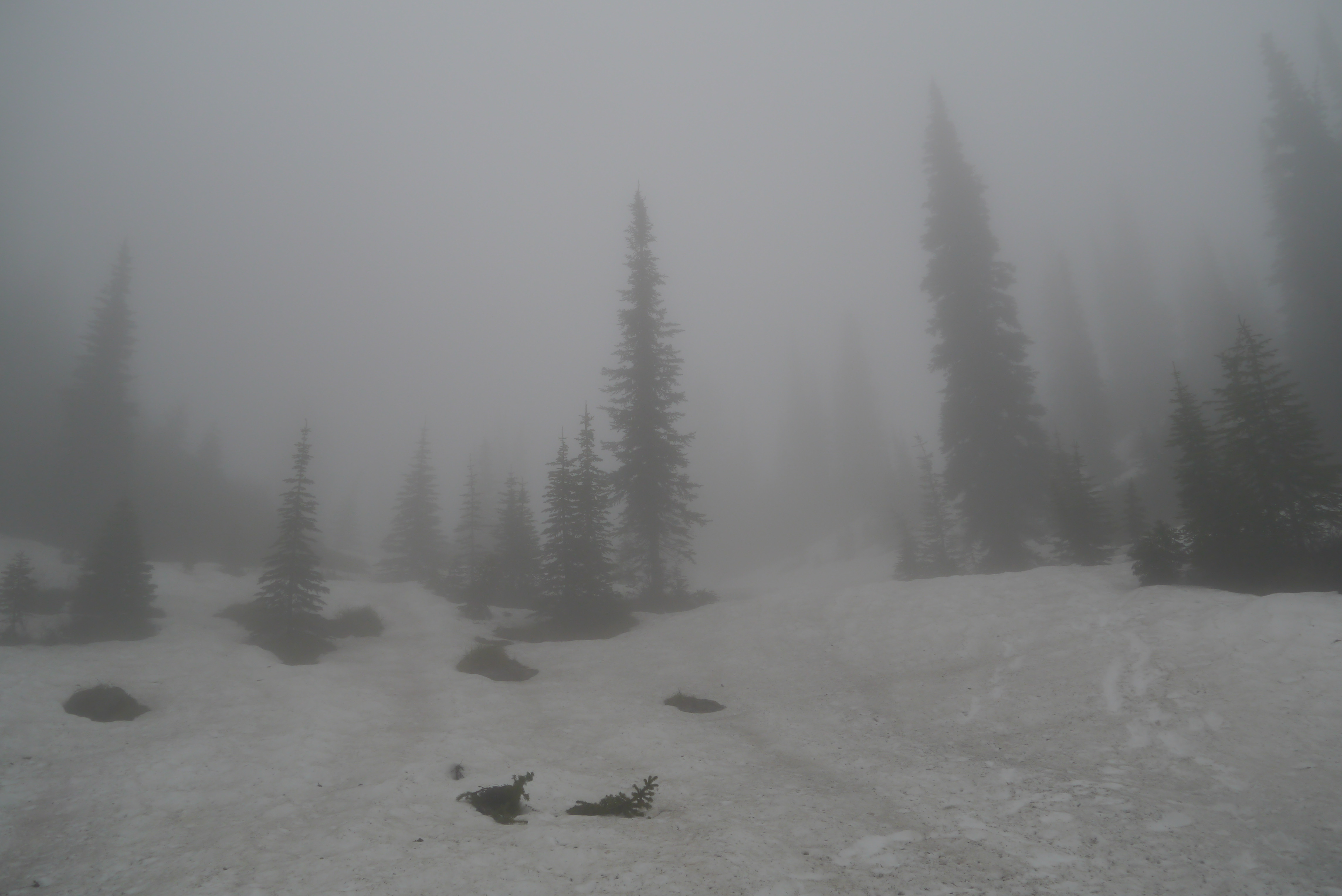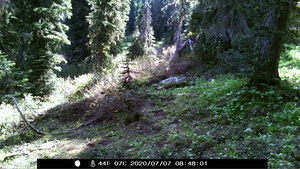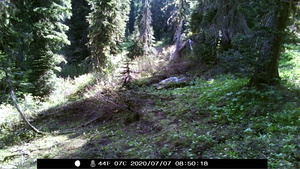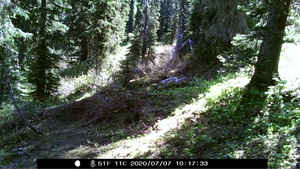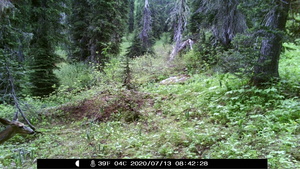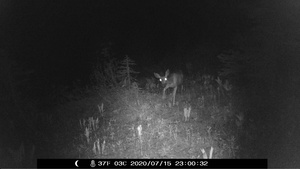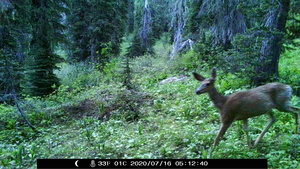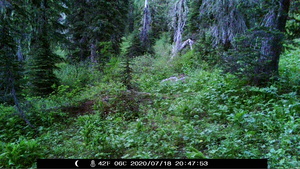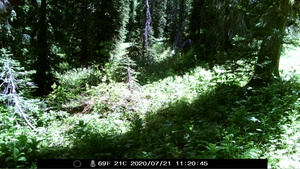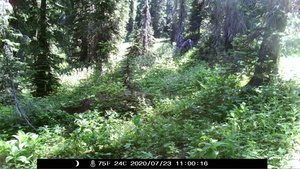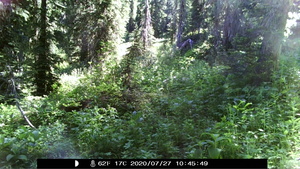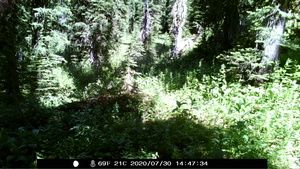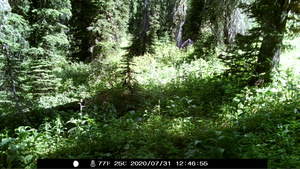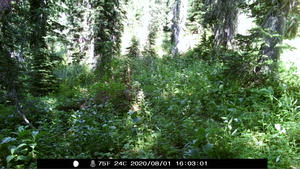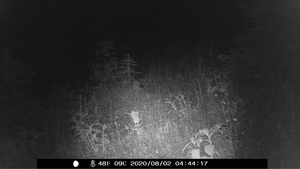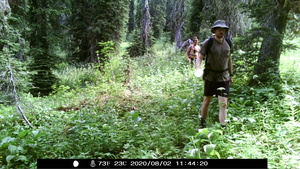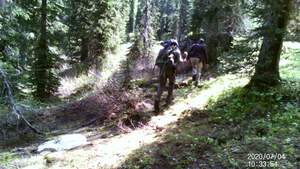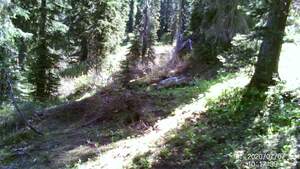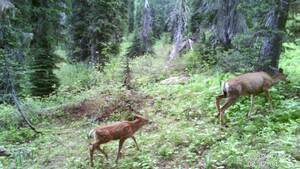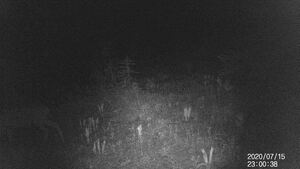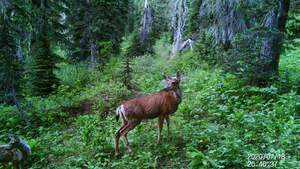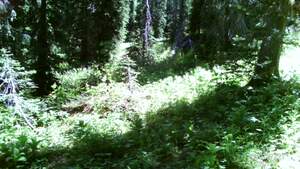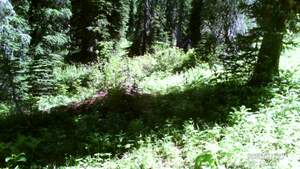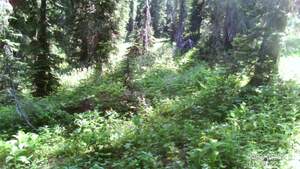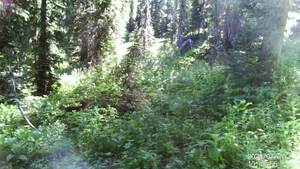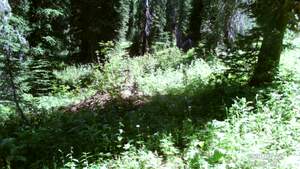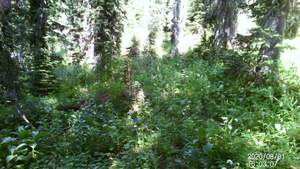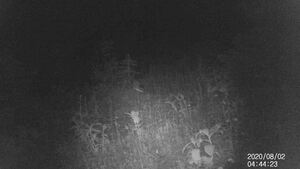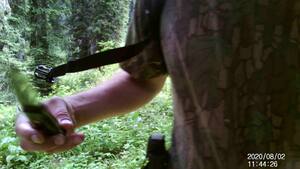To Sleep Beneath its Unhinged Doors
Dreams and Encounters in the Ruins of Caribou Country
by Chris Lamb
I wake up early. The sky is clear above our campsite but a veil of rain is sweeping through the forested valley below, consuming distant peaks. The wind is shifting. After lighting a fire to dry my socks and boots, I sit quietly beneath a small black tarp, drinking hot coffee with my bare feet near the flame, watching the weather in the distance. It’s almost silent here except for the slight breeze, the crackling wood, and the crinkling sound of the tarp as it inhales and exhales with the wind. Aside from the far-off rain and the few mountain bluebirds I can spot darting between the bone-like standing dead trees, the landscape is seemingly vacant.

A shot from Google earth would depict a skeletal forest draping over the ridge flowing west in the direction of my vision, spliced every so often by a vein of old growth timber, peppered here and there with the emerging green of a budding understory. The snag forest, with its trees stripped of foliage and limbs, is the reason I have such a clear view of the space laid out before me. If not for its nudity, I would be enclosed, screened, and protected from the wind by ancient, heavily clad trees with thick beards of lichen.
But the recent wildfire has exposed this ridgeline and provided an expansive view of the Salmo-Priest Wilderness—a 43,348-acre swath of what appears to be untouched forest straddling the invisible border between northeastern Washington and northwestern Idaho, located in the South Selkirk mountain range.
We’re camped on the Idaho side of this line, at about 6000 feet and roughly two miles shy of the Canadian border, on the protruding cretaceous granite of the Idaho Batholith’s Kaniksu lobe—a sixty five million year old rock that rested, in its infancy, beneath the depths of the Pacific Ocean. My two friends and (for the purposes of this trip) colleagues, Jack Kredell and Michael Decker, are asleep in the tents about twenty yards behind me, in a small grove of subalpine fir and Englemann spruce trees. They’ve been there since we retired last night after an exhausting ten-mile hike in. We arrived just before dark and had barely enough time to set up camp, light a fire, and cook a freeze-dried meal. At that point the weather was fair and the scene I’m observing right now was under mostly clear skies, punctuated at dusk by a gilded horizon. The wind picked up after sundown and we heard thunder and saw flickers of lightning in the distance. But as far as I know, no storm passed over our site.

This is our second of what will be many trips into these mountains this summer. We’ve been drawn here primarily by the recent extirpation of the South Selkirk mountain caribou, an animal that was specific to the rocky alpine ridges and the old growth, lichen-heavy forests that a decade ago would’ve surrounded me.
The caribou inhabited these mountains, residing mainly at the highest elevations—to avoid predators—except for early winter, when they collected beneath the dense canopy of the cedar-hemlock forests lower down. There, they would feed on lichen-bearing deadfall and remaining summer forbs until the snow piled high and dense enough for them to reach arboreal lichens in the sub-alpine zone—where they would spend winters feeding in the thick silence of snow-draped spruce and subalpine fir. Unlike the barren ground caribou of Alaska and other arctic regions that migrate long distances and in large numbers, the mountain—or black caribou as some refer to them—have evolved to migrate vertically and in smaller herds. They are an ecotype of woodland caribou (Rangifer Tarandus), a subspecies of the North American caribou, that at one time inhabited most northern regions of the United States, including parts of Maine, New Hampshire, and Minnesota. While the majority of woodland caribou vanished from the lower-48 by the late nineteenth century, Idaho’s mountain caribou were able to outlast their relatives by, as Jack puts it, “migrating annually to the arctic; a migration not to colder latitudes of the Far North, but to colder altitudes in the Selkirks” (Kredell 5). That is, until January of 2019 when the last two were captured in a net and airlifted to a captive breeding program in BC.
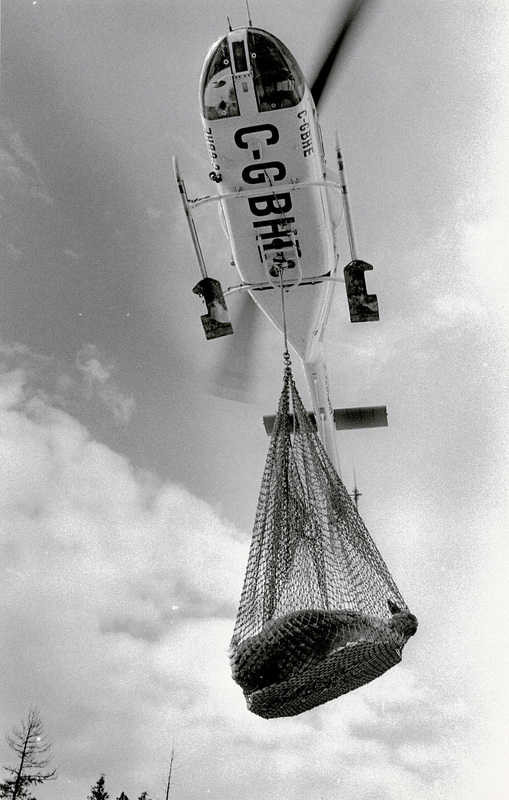
The plight of Idaho’s South Selkirk caribou population is a familiar story. With their survival relying so heavily on predator avoidance strategies, caribou existence depended on the preservation of a unique spatial arrangement that promised seclusion. For years, the deep snow and harsh conditions of the alpine zone were enough to maintain limited contact with animals that posed a threat to their world. But over time, habitat fragmentation due to anthropogenic forces such as logging, road building, recreational snowmobile use, and climate change (wildfires and snowmelt included), slowly chipped away at this protective layer, puncturing, incrementally, the caribou’s evolutionary line of defense.
We’re here on a University of Idaho library fellowship to, in essence, track the ghosts of these animals and to produce a spatial representation of caribou absence in this area. Throughout the summer, we’ll be setting up game cameras in and around the former caribou habitat in order to produce a deep map, or multivalent, interactive spatial narrative. The idea is to represent the space without caribou by capturing footage of the beings that continue to inhabit the area, each of which, unwittingly, played a role in the constitution and/or collapse of the caribou world. An important component of this project is oral history; in addition to the footage collected here, we are conducting interviews with locals who have had encounters with mountain caribou in the wild, as well as scientists who were involved in efforts to protect them. But today we’re focused on setting up game cameras.
The shadow of winter is still present at 6000 feet in the Selkirks this time of year. Though it is mid-June and very much summer back home in Moscow, Idaho, the snowpack persists at high elevations, where temps continue to drop below freezing. I’m resting on a patch of recently exposed ground where we’ve set up our cooking area and fire pit. But Jack and Michael are bedded down on a mass of deep, hard-packed snow that covers most of the surrounding landscape, especially the shadows where there are pockets of living trees, and the snow is up to six feet deep.
Our hike yesterday was impeded significantly by this enduring snowpack. We arrived via the Shedroof Divide trail, which begins northeast of the Lake Sullivan Ranger District outside of Metaline Falls, in northeastern Washington, and cuts through the Salmo-Priest into Idaho. The weather was pleasant and the ground clear for the first few miles of our hike, but when we reached the summit of Shedroof Mountain, which just now rests in the corner of my left eye, the trail withdrew beneath the heavy, wet remains of winter. From then on, it was only intermittently visible, revealing itself on the sunny, southerly facing slopes and disappearing again in the shaded spaces and northern aspects. This created obvious navigational challenges, leading us to rely almost entirely on our GPS systems to stay on track. It also demanded much of our bodies, as we were persistently punching through soft layers and struggling to stay on our feet.

At the top of Shedroof, the trail-less ridgeline led us to a steep, rocky face on the northwest side of the peak. Because of the snow and the grade of the mountain, there were few options for descending safely. We scoped several alternative routes but each one came with its own risk, the most likely being a wet, spring avalanche. So, we opted eventually to climb carefully down the face, clinging to stunted subalpine firs and exposed granite to avoid falling and potentially triggering a slide. The snow was over my head in places, peeling away from the radiant warmth of boulders and tree trunks, leaving large glide cracks on the surface. From my experience skiing in the backcountry and my basic understanding of snow science, I was aware that these were less than optimal conditions for scaling a mountain face. And the added weight of our packs contributed to my insecurities about the rotten, sun-cooked snow—its layers ready to shed like the snows of deep winter from the broad backs of bedded caribou.
After about seven hours of hiking, and four with soaking feet, we still hadn’t made it to where we’d hoped to camp, which was on a saddle about two hundred feet below the summit of Little Snowy Top—the last stronghold for mountain caribou in this region. So, with the day dimming we set up camp here, about two miles shy, in this open grove of standing dead trees, in what typically, this time of year, would’ve been prime calving grounds for female caribou.
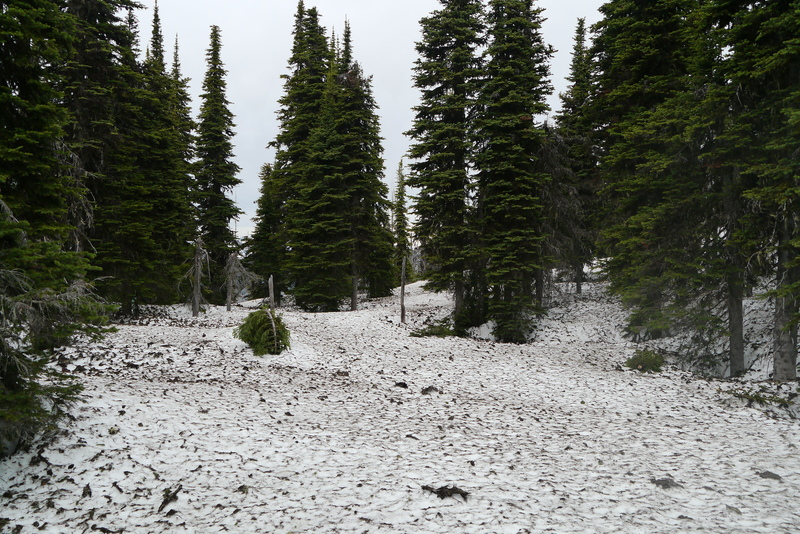
Though inconvenient, I do appreciate the snow. It carries with it, in some capacity, the spirit of the caribou whose lives were inextricably linked to its presence here. This is the first snowfall in many hundreds of years that will turn to runoff and become a major part of this watershed without carrying with it the tracks of these animals. Somehow, being here on the edge of this patch of slowly melting ground is like witnessing the first traces of caribou absence—not as a singular event instantiated by their forced removal, but as a process that began long ago, one that will continue to permeate this landscape in ways both visible and invisible.
My insecurities about the weather take me on a search for an alternative campsite. As I walk the ridgeline I pull out my binoculars in hopes of catching something moving through the forest or upon the mountain crest. I imagine a grizzly bear, a mountain lion, a wolf. I imagine a caribou. I see nothing but the patience of lichen and trees in the wind, the remnants of fire, the slowly departing snow.
When I return from my search, Jack is awake and sitting by the campfire preparing his own coffee. He’s dressed in his usual mountain apparel—-lightweight Kuhl pants, a camo long-sleeve wick dry tee, a beige Hells Canyon National Recreation Site cap. His binocs are strapped to his chest like a safety vest. He appears to be fixed in contemplation, staring into the Salmo-Priest, working on a Cliff Bar. I don’t know what’s going through his mind, but I imagine that he’s trying to picture the scene as it was in 1490–a thought experiment that I’ve come to realize is one of his prerequisites for entering any new landscape. Jack would gladly give up several years of his life to spend one day in the pre-contact west. And in moments like this I often wonder if he’s somehow found a way in. When I approach he nods through the steam of his boiling water and I bring up my concern about the weather.
We decide to relocate to the opposite side of the saddle, to a more protected space. When we return to the original camp Michael’s tent is vacant but he’s nowhere in sight. We continue to gather firewood and carry various items to our new shelter. And eventually he emerges from the trees. He’d gone after the bear bag he’d slung high up in an Englemann spruce last night—a task he’s become proudly proficient in since our first trip this summer. His long, curly hair is bouncing out of his yellow beanie. He’s smiling and looks—as always—like he’s exactly where he needs to be.
The snow is slick and soft as we travel toward Little Snowy Top–our destination for the morning. The caribou had adapted snowshoe-like hooves that allowed them to float on top of this snowpack like leaves on water. The challenge of staying on the surface is one of the main reasons why predators were unable to reach them. My appreciation for this evolutionary technology is increasing with each precarious and exhausting step. We cover two miles in more time than we’d predicted. But the now open sky and views of Continental and Kaniksu Mountains, Upper Priest Lake and the Selkirk Crest draw long pauses. Continental Mountain lies on the eastern side of Little Snowy Top and the Upper Priest River. It’s a rather unspectacular, elongated peak with a rocky top that reminds me of the weatherworn granite of the White Mountains back home in New Hampshire. I think it’s this quality that draws me to it—the reminder of home—but also its fascinating history.
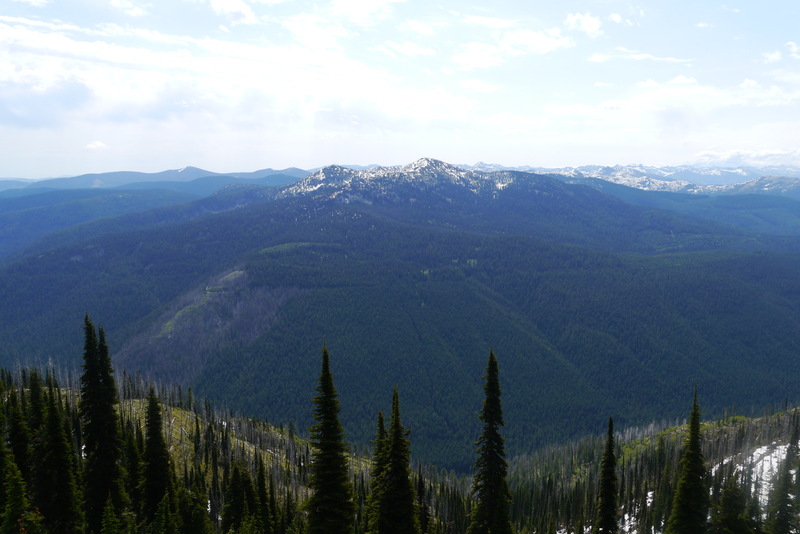
At the turn of the twentieth century, a man by the name of Billy Houston overwintered alone on Continental Mountain. He was protecting his claim on a silver-lead ore deposit that would later become the Continental Mine. It is said that this “ore body was exposed on the bare summit of the mountain for a length of about one thousand feet and from fifty to one hundred feet in width,” with “some solid clean ore eight feet wide protruding several feet above the surface of the bare rock” (Klockmann 20). Houston, desperate as he was to claim this ore deposit, survived almost exclusively off of caribou during his winter on Continental Mountain. He’d erected a tent made from caribou hides, ate caribou meat, and wore caribou skins. In his diary, A.K. Klockmann, a German immigrant and prospector, and the eventual principal developer of the legendary Continental Mine, describes encountering Billy off Cedar Creek in the Priest Lake area. Klockmann, following rumors of Houston’s find, had made several attempts to locate the man and the mine with no luck. Until one day, while camping at the foot of the mountain on Cedar Creek with his dog, Prince, and his companion, Pelke, Kockmann observed Houston emerging from the woods in a beyond human form:
“We had but just prepared for camp when Prince growled and Pelke touched my arm and pointed to a walking object in the distance coming towards us, both of us wanting to know what in the world it might be…Coming slowly nearer after a long wait we realized that it was a man clad entirely in caribou hides, even his headpiece covering part of his face, and stepping out to meet him discovered it was no other than Billy Houston in pitiful physical condition from exposure in deep snow all winter with nothing but caribou meat to live on, even without any salt for several months. His eyes, nose and ears were badly affected, even for sometime his mind.” (31)
I wonder often at Houston’s determination and the kind of madness or desire that would drive someone to live alone in these mountains for a winter. But I wonder more at his relationship to the caribou. It is one thing to survive a winter alone in the Selkirks, another to rely so entirely upon a singular being for that survival. Houston likely went weeks without encountering any animals other than caribou, and considering their lack of wariness toward human beings, he likely spent hours, perhaps even days amongst their herds, observing them in a way that no biologist ever has. Houston emerged from the woods on that day in a form that was almost more caribou than human. And the image of his face, half covered by the hide of a caribou, emerging from the shadows of the old-growth forest, to me, gestures toward a kind of transformation that no one else could possibly understand. The caribou certainly lived on in Houston in the years following, and I can imagine that, in some ways, he felt the soft underside of that hide eclipsing part of his face in every encounter he had with a human being from that day onward.
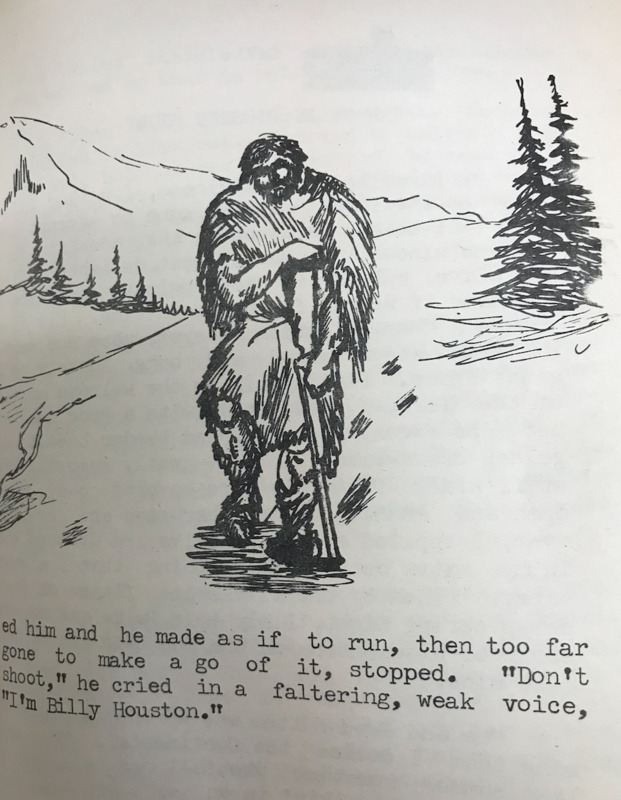
When we reach the summit of Little Snowy Top, the sky is still clear and the sun is heavy on the snow and our skin. We spend some time glassing distant drainages and greening avalanche paths. In addition to being critical caribou habitat, this region is also a grizzly bear recovery zone. And since the bears follow the green-up in the spring to feed on emerging grass shoots, and to acquire the sugars they crave following hibernation, we anticipate that we might spot one in a recently exposed area. I gaze intently through the etched glass of my binoculars, once again imagining what I might see as if I could will it into being. A cat lurking on a distant rock outcropping. A bear or two digging for bugs or shoots. An elk. A hoary marmot. A wolverine. But we don’t see any critters. And we spend our morning simply peering into the outstretched space that, until now, has only occupied our imaginations.
The region laid out before us—an open ridgeline connecting Little Snowy Top to the more massive Snowy Top, the subalpine-spruce forest stretched out between them–now mostly standing dead trees, is where the last sighting of caribou took place here. We’d hoped to set a camera down there but the distance, again, is larger than we imagined, and we decide to save the energy. We still have cameras to retrieve at our site from two weeks ago, four miles through soft snow in the opposite direction. And, again, we need to be conservative considering the potential weather. Personally, I’m disappointed. Sitting here, looking into this area, it feels as though we’re not quite there, not quite at the center of the event where I had imagined our project commencing.

At the summit of Little Snowy Top lie the remains of an old fire lookout tower that burned down in 2016 when a small group of hunters supposedly lost control of the wood-burning stove. It’s the first thing you see when you crest the summit: six cement footings supporting nothing but the open sky. The ground between them littered with melted glass and metal, nails and rebar. A single charred beam straddles the southern columns. Part of an aluminum extension ladder lies mangled atop the ashes. The only intact object amongst the rubble is a light blue door that must’ve fallen off its hinges before the flames got too hot.
For almost a century, this 14X14’ wood frame cabin held windows that provided a 360 degree vantage over a large portion of the South Selkirk caribou range. From inside, one would’ve been able to gaze out beyond Continental Mountain and the Upper Priest River to the east, toward the serrated skyline of the Selkirk Crest, and in each direction over a landscape that we know the caribou moved through for centuries. Through this glass, visitors likely saw small herds making their way down the ridgeline from British Columbia, up and over Snowy Top, and into the high, forested basin between the two peaks in winter. They might’ve seen bulls and yearlings as they descended to lower elevations in spring, leaving behind the calving cows to meet them again after giving birth. It’s likely they would’ve seen them in summer, too, following the green-up in the avalanche paths on the southeastern slope, feeding on twisted stalk, canby’s licorice root, and fools huckleberry. And, when the first flurries fell in the winter months, they watched them disappear into the shadows of the cedar-hemlock bottoms, only to emerge when the snow was deep enough to lift their muzzles into the lichens up high.
In the thirty years of its operation as a Forest Service fire lookout, and the fifty or so years following, the people who visited this windowed watch witnessed a history that, cumulatively, would’ve told the story of extinction—the slow, almost silent, whimper of a world on its way out. Surely the sightings were fewer and fewer as the years progressed, and what was likely a typical occurrence in the early part of the century became, toward the end, an unexpected encounter.
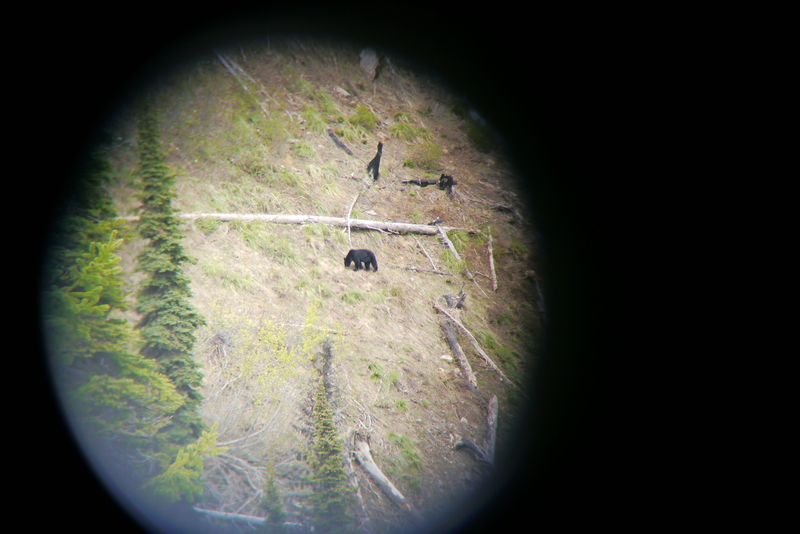
As we prepare to make our way down the mountain and back to camp, we pause for a moment in the remains of the tower. The glass and nails and metal crunch beneath our boot soles as we investigate the wreckage.
“Can you imagine what it would’ve been like to sleep up here in a cabin? At over 7000 feet with that howling wind?”
“The perfect balance of protection and exposure.”
“And watching that sunrise over the Selkirk Crest?”
I imagine the sunrises and sunsets, the rain and wind storms, the gray and blue and golden days. I imagine the snow creeping up the glass late in winter, threatening enclosure. The way it must’ve felt, arriving here on snowshoes and lighting the little woodstove. The way the firelight flickered in the glass.
It’s almost incomprehensible to imagine the hours of looking that took place here, the many sets of eyes, the stories.
I wonder, again, at the possible caribou sightings.
The three of us stand with heads down, kicking through the pile of miscellany. A grill grate. A paint bucket. Rusted rebar. Smaller debris brushed into rock crevices by the wind. Now participants in the larger geological process, they await to be worn down by the weather, to be swept off the surface and eventually worked back into the world. A strange, slow comingling of human and mountain time. We pay particular attention to the globs of contorted metal and smooth, melted glass that most clearly hold the memory of the fire’s heat. We turn them in our hands. We drop them and pick up new pieces. Though sad and strange, there’s also something beautiful about them. Their shape and way they’ve become something else without trying, the way they catch the eye. They seem to contain time and space in a sort of unconscious material memory.
I’m reminded of an essay by Rebecca Solnit, where she writes that ruins are also treasures: “our links to what came before, our guide to situating ourselves in the landscape of time.” Solnit writes mostly of urban landscapes and how our haste to cover over and replace (or refurbish) zones of disaster is indicative of a larger blind spot in the American imagination. After all, America was built on the erasure of inhabited landscapes and the imposition of a very particular and violent relationship to space—one that cowers under the backward glance of history, and is often illuminated by ruins. The notion that memory and human shortcomings are somehow revealed and preserved in wreckage feels strikingly relevant here.
After twenty or so minutes of rummaging around in the rubble, each of us pockets a small piece of metal and we begin making our way off the summit and back toward camp. We still have a couple of game cameras to set up, and we’re losing light. We’re quiet as we climb back onto the snowpack and find our footing upon it and the rocks. Sliding at times, punching through at others. We comment on the fir trees that cling low and narrow to the rocks, the way they collect water from the clouds, the way they, too, have been in the presence of caribou.
At a point just below the summit, out of sight of the fire tower remains, we detect a distant sound from the trail—like the voices of a radio show playing off a portable speaker. So we stop and await the anticipated encounter. When the voices are accompanied by footfalls in the snow, the image of a young man appears through the fog that has begun filling in the spaces between things. He doesn’t notice us at first, but when he does he stops. He sighs. He looks up. He’s in a yellow and blue hoodie, wearing jeans, a ball cap, and carrying nothing but his iPhone and a small Burton day-pack. He’s close to our age, maybe thirty-five.
“Is there a fire tower up there?” he asks.
“There used to be.” Jack responds.
It turns out he’d stayed in the cabin with a group of friends a decade prior and hiked the ten plus miles out here alone today to spend the night. He had no idea it burned down. And he doesn’t appear to be prepared to spend the night without a shelter—there’s no way he has a tent in that daypack. It’s hard to imagine he has extra layers, let alone a sleeping bag. He continues to question his new reality until he climbs up higher and sees the ruins for himself.
Now silhouetted against the sky above us on the summit, observing the space we’ve just left behind, he pulls out a bag of potato chips.
“Shit.”
“Do you have a sleeping bag?”
“Yeah, I’ve got a 40 degree bag.”
It’s supposed to drop below freezing tonight. The wind is increasing and the air is damp. I’d be unlikely to survive the night up here without layers and a twenty-degree bag, I think to myself.
Jack suggests that the door might work well as a windscreen if he decides to spend the night. He could position it in a large groove between the rock and a small patch of subalpine firs. We show him where we think it might fit best. It won’t be comfortable, but it’s better than nothing. I shiver at the thought. We offer him our tarp and then, after a quick deliberation, a spot in Michael’s tent if things get bad.
He hesitates at the offer, says he’s going to rest for a while before making up his mind. He pinches another mouthful of chips from the bag, looks around. Shit. He doesn’t seem eager to spend a night with strangers. And though he appears grateful for our thoughts and offerings, he radiates a strange disinterest. Knowing we’ve done what we can, we leave him in the rubble and continue our descent down onto the ridgeline.
I struggle to sleep because of the cool temps, shivering in a 30-degree bag with long underwear, a wool hat, and protection from wind and moisture. I get up to piss several times. The Mountain House freeze-dried dinners we’ve been eating make me feel perpetually dehydrated, which in turn leads to excessive water drinking after meals. I am very much unmotivated to unzip and crawl out into the cold, damp night. I take my wool socks off so they won’t get soaked in the wet grass surrounding the tent. And when I’m out there, I listen, as usual, for the sounds of others–footfalls, howls, hoots, the wind. When I settle back in, my thoughts drift periodically to the summit and the memory of the man standing there in the midst of his miscalculation. We don’t know if he decided to leave—we didn’t see him again today—and I’m frightened at the idea of him spending the night up there. I’m certain that, if he’s there, he isn’t sleeping. And I question whether it’s even possible to survive such conditions with so little protection.
In the morning we drink coffee made with boiled snow and wait for the sun to release our bodies from the cold snap. Jack and I are up first. We spend more time glassing, constantly looking for the grizzly, for anything. Content in his personal tent, with his books and his journal, Michael snores through sunrise as we sip our instant packets of caffeine. He’ll be up in an hour or so and we’ll begin our journey toward the summit of Snowy Top—our main objective for the day. But for now we relax and talk about where we’d like to place the next cams. Jack, who’s more experienced when it comes to tracking and anticipating animal movement, recommends putting one up in the basin between the two peaks. We also discuss the possibility of setting one on the ridgeline. But it’s still early in the season and hard to tell where the most traffic will be without clear and recently used game trails.
As the coffee starts working we hear the sound of footfalls amidst the droned voices of a podcast. Working down the mountain like a katabatic wind, the young man walks by. He doesn’t acknowledge our presence, though we are no more than twenty yards away. And with his eyes set on the trail, his mind surely on home, he disappears from our field of vision.
Later in the day we make our way down into the basin and place a camera in a clearing about a quarter mile below the ridge connecting Little and Big Snowy Top. We fill our water bottles at a steadily flowing spring just off the trail. Proximity to water, open space, and the greening plants, including twisted stalk—a primary summer food for mountain caribou—make it a prime location for hanging a trail cam.
We summit Snowy Top around noon, climbing on all fours up a steep slope without a trail. Though sunny and clear, the wind is strong and the grade of the mountain, which has few secure handholds, makes me nervous. I consider turning back but feel determined to summit one of the tallest peaks in north Idaho, the backside of which flows down across the border into Canada. Though we won’t be hanging any cameras up here, it feels like a necessary part of our project to reach the summit and gain a new perspective on the space we’re attempting to map. On a peak that supported migrating caribou hooves not long ago.
The view from the top provides a miles-deep gaze into Canada and the northern portion of the South Selkirks. We can almost see the rocky bottom of the Upper Priest River from the summit. Fish rising. And we have a new vantage on the backside of Little Snowy Top, which now reveals a boulder field on its northwest slope—where I imagine a cougar sleeping in one of the many openings.
“It’d be pretty easy to rally a crew to come and clean it up,” I say, talking about the fire tower remains while making our way back to camp.
“I’m actually surprised they haven’t.”
“Yeah, I don’t know, man.” Michael hesitates on the idea. So does Jack.
“I’m not sure I think it should be cleaned up.”
“You know?”
We discuss this for some time—the ethics of a potential clean up—and the inherent desire for purity in the places we consider wilderness.
“It reproduces the idea of humans as somehow separate from the natural world.”
“Cleaning it up would erase the history of our presence here.”
And this is true. At first, the ruins are an eye sore. They impede the otherwise pristine experience of the mountain summit. The one where we are the only sign of human encroachment. They prevent us from walking freely over the ancient granite of the Idaho batholith, from taking an untainted panoramic photograph. From feeling like we’re somehow alone out there, both in time and in space.
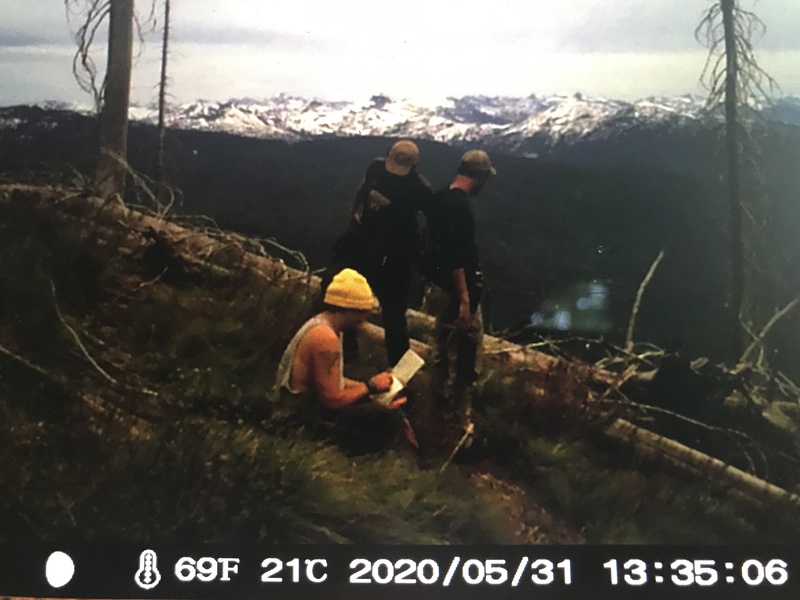
But I keep returning to Rebecca Solnit and the idea that ruins are somehow necessary. Without the ruins of the fire tower, the memory of a particular human presence in this landscape would be erased, and with it a deeper, more textured sense of time and space. The metal and glass and nails, the blue door, all hold the memory of a passion for the remote and wild landscape. They are traces of an idea inhabited by men and women who longed to be in the solitude of the mountains, to, in their own way, make contact with a world that preexisted European settlement, industrialization, and the denigration of intact ecosystems. Embedded within this idea, somewhat ironically, is the continuation and perpetuation of a colonialist mindset. The fire tower represents the presence of a watchful eye over an imagined, tamed, and pure wilderness, and the suppression and control of fires that were for centuries fundamental to the health of this landscape. And by extension the control over indigenous peoples whose histories are inseparable from these fires, this landscape, and the violence of colonialist policies. The idea of a landscape without history, an atavistic space that fuels the spatial amnesia that is in many ways foundational to the American imagination is preserved, somehow, in the ruble there.
This memory is inseparable, too, from the memory of mountain caribou, whose ruins are less visible but still very much present in the landscape. Peering out from the locus of the mountain summit, it is easy to be tricked into seeing a more or less untouched wilderness. A few Forest Service roads in the valleys and the power lines strung along the international border are the only signs of immediate human presence. Yet the western aspect of Continental Mountain to the east bears a large, rectangular swath of lighter, more homogenous looking forest—traces of the timber and mining industries. The ridgeline stretching south from Snowy Top is a graveyard of old growth subalpine fir and Englemann spruce, where standing dead trees hold—in their own way—the memory of the 2006 wildfire, climate change, and the history of fire suppression. The early seral habitat created by these natural and man-made ruins are prime feeding ground for whitetail deer and other ungulates that, while not destructive in their own right, have attracted an influx of predators that previously did not venture to such high elevations. And all of these factors gesture to the absence of caribou today.
Clouds spill into the open blue above us as we make our way back to camp. The rain I was watching earlier is now approaching in earnest. Trees are sifting fog and the temps are dropping. When we arrive at our packs and our shelter we layer with the appropriate gear. I’ve got a Gore-Tex jacket and rain pants under a translucent five-dollar poncho. Michael a purple raincoat. Jack a rain jacket, water resistant pants, and a camouflage poncho that seems significantly more durable than mine. With the tarp now in a more protected space, room and plenty of fuel for a fire, adequate supplies, we feel prepared for whatever weather the mountains decide to throw our way.
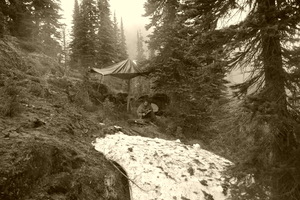
At camp
Jack and I head out to collect the two game cameras from our first trip while Michael decides to stay back and do some writing. We’d come in on a different trail two weeks prior and camped roughly two miles south of where we are now, so we’ll have at least four miles of hiking through snow and rain before settling in for the night.
The camera we’re most eager to retrieve is situated on an overgrown logging road, just above a little spring trickling into the Priest River watershed. We observed two black bears working the drainage on our first trip, and after setting up the camera watched them make their way onto the road in exactly the same spot where we had placed it. The region we were in then was at a lower elevation and seemed to be thawing rapidly compared to our current campsite. The early bear activity was promising for collecting footage so early in the season.
When we make it off the socked-in ridgeline and onto the bare, wet, and freshly greening ground, the energy of the space suddenly changes. The rain is now in full force, mist sweeping over chunks of bear grass, fogdrip collecting on the trees, and even our ponchos seem to be soaking in water. I’m drenched at the shoulders and torso and, of course, at my feet. There are piles of fresh, green, bear shit every ten strides. At least it seems that way. Working our way down the exposed hillside toward the overgrown road, it feels as though we pass through some kind of threshold. For some reason, I feel much safer high up on the snow-covered rocks. Down here, it’s clear that we’re in something else’s territory.

It’s hard to find our camera because the road, which was under at least 4 feet of snow when we set it up, is now thick with alders. We can’t see more than ten feet ahead of or behind us. And I’m on edge thinking of how likely it is we bump a bear down here. We spot a tree with claw marks nine feet high and at first wonder if it was where we’d hung the camera. Likely a grizzly bear. I tell Jack, in a shaky voice that it’s probably gone, that we should get the fuck out of here. “Let’s just go a little farther,” he says, clearly drenched and exhausted, but, as usual, willing to lean a bit farther in to the vulnerability of being out here than I am.
We eventually find it—twisted sideways on the subalpine fir we’d strapped it to. It had been tampered with. Perhaps on the same day we’d set it up, when our scent was still heavy there. We pull it off the small tree and place it in Jack’s pack, relieved and excited to look at the footage when we arrive back at camp. We decide to bushwhack pretty much straight up the hillside above the road to get back on the ridge and hustle toward shelter. We’re both wiped out, certainly dehydrated. Consistent movement is the only thing keeping us from freezing. It’s difficult but good to be passing through this country.
Despite having been at the campsite during our trip to retrieve the cameras, Michael is soaked when we return. He tells us that he spent the duration of our journey reinforcing the shelter. “Shortly after you guys left, the wind picked up,” he says. “The rain was coming in under the tarp and I had to hustle to shift things around and build a stronger enclosure for the fire.” The fire pit we’d left behind was a simple ring of stones with a piece of bark placed on top to protect it from the rain. Now, it’s a work of art—a towering wall of tightly placed rocks with a beautiful granite slab roof. This kind of architectural feat is not an uncommon phenomenon when camping with Michael, who, earlier in the summer, built a temporary shelter out of driftwood for us to sleep in on the edge of the Selway River. But despite its beauty and impressiveness, it’s not enough to keep us warm or dry. Huddled together under the small black square of the tarp, shivering, using whatever energy we have left to prepare our freeze-dried meals, we realize that we’re in over our heads. And there’s a sudden shift in mood when Jack opens the game camera to find that we forgot to turn it on when we set it up. It had been hanging there for three weeks, capturing nothing.
At 5:30pm we decide our only option for staying warm is getting in our tents and sleeping bags and waiting it out until morning. We can’t manage to stay dry and Michael, in particular, is shivering in a frightening way. The steady tremble through his body–like a signal from the mountain–is all I need to know that we are no longer, and perhaps never were, in control here. It’s not below freezing, but it doesn’t need to be for hypothermia to take hold. I lie here in my thirty-degree bag, warm but damp, staring at the grey threaded fabric of my tent, thinking about falling dead trees. I’m thinking about the one just outside of our tent, wanting to relocate when at 6:30pm we hear an unexpected chorus of voices and footfalls approaching our site. A strange but somehow comforting feeling.
I hear Michael’s voice projecting toward the on-coming party. And I decide to unzip and poke my head out of the tent to join the conversation.
“You’re beautiful,” I say, to the group of three—a muscular and tall man in short shorts with a thick brown mustache, wearing sneakers, led by a former marine with a sidearm and a camo rain jacket draped over a large frame backpack. He’s in a t-shirt. The rain is falling steadily. The two men are followed closely by a young woman. She’s quiet, carrying hiking poles, a small daypack, also wearing sneakers. She has a dog in tow. They are wet and, clearly, also underprepared.
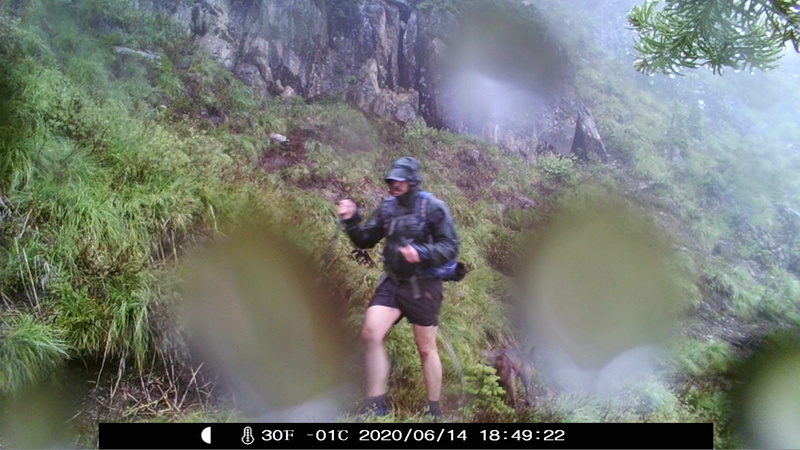
They tell us they’re hiking the loop from the Salmo-Priest trailhead, that they started early in the morning, and that they’re making their way back to the car tonight. I can’t imagine anyone trying to hike out of here at this hour and in these conditions, especially with the inconsistent trail.
“It’s about four miles,” says the marine, who’s also carrying an iPhone—his only means of navigation.
The trail they’re taking is not the one we took in. It bypasses Shedroof Mountain and ends at a different trailhead, a few miles up the road from where we’ve parked. Still, the thought of a party hiking out of here just before dark in such conditions and with so little gear makes me wonder if we might try to do the same. We’ve got ten miles, as opposed to their four (which is probably more like six or seven), but we’ve got GPS, more gear, and would be prepared to stop and spend the night if need be.
Knowing that we’ll be fine if we just stay in our tents until morning, but still feeling slightly on edge, I ponder this option restlessly when the party passes on. But I don’t mention anything until Michael eventually speaks up.
“What do you dudes think about hiking out tonight?”
I tell him what I’ve been thinking and that I think we could make it. Jack says he’s concerned about how much we’ve already hiked today—altogether about eleven miles—and he’s worried about his knee holding up. But he also says he’d be up for it.
“If we can make it to Shedroof by sundown, then it won’t be too bad to hike down the mountain in the dark,” I say. “It’s 7:00 now. I think we could get there in two hours.”
We decide that if we catch up to our friends we could hike out with them and possibly get a ride to our car, which would allow us to avoid the climb up and over Shedroof. But when we do eventually meet them on the trail, they turn us down. They tell us they don’t have room in their Nissan Xterra, but it’s clear to me that we make them feel uncomfortable. And I wonder if it’s because I told them they were beautiful.
The last time we see them is in a notch on the saddle connecting Snowy Top in Idaho and Shedroof in Washington. We’re standing, both parties, on the thick snowpack with the trail hidden beneath us. Them on the far side of a deep funnel that cuts through the middle of the notch, beneath towering spruce trees with long, cool strands of water-soaked lichen, holding the iPhone under the pelting rain, looking for the trail.
It’s dark when we arrive at the base of Shedroof’s summit— the steep face we’d climbed down on the way in. Our GPS stopped working once we crossed the border because we only loaded maps for Idaho. With headlamps on, we pause beneath the snow-covered precipice and glance up at dark shadows of wet rock outlined by the dim white of snow, the still-visible tracings of our footsteps from two days prior leading into a fog-shrouded abyss. But we can’t stop for too long. It’s cold. And our bodies are tired. I have to move constantly to keep my core temp elevated. This frightens me when I think about the obstacle in front of us and the distance we have yet to cover, the potential that we might actually have to stop and set up a tent for the three of us to pile into, perhaps naked, for several hours to stay warm. The potential that one of us could easily be injured during this stunt. I’m realizing now we’ve made an irrational decision in leaving the safety of our camp to hike this distance in the dark.
Images of home surface and I long to be in the comfort and safety of my apartment back in Moscow. It’s the same feeling I had several weeks ago, huddling in our tent on the ridgeline as a booming storm cast 15,000 lightning bolts on the South Selkirks with no consideration for our lives. The same desire to retreat that surfaced as I crawled, suspended on a wet and slowly rotting cedar tree, over a violent and unforgiving Upper Priest River we had no other means of crossing to make it back to safety. These are unnecessary, and perhaps stupid, risks.
I am almost convinced that I’d rather be there than here. It surely would be easier to sit at home and read about caribou, and less life-threatening. And who are we, anyway, to think we’re going to come out here and map caribou extinction? Pretending that it’s at all possible to do so, that it’s at all possible to comprehend the absence of mountain caribou in the South Selkirks. Or any species for that matter?
I take a sip of water filtered from a snowmelt stream a few miles back. I look at Jack and Michael, their bodies fading in the gathering dark. Our breath clouds mix with damp air, ascend above our light beams, and vanish. Despite our exhaustion there’s a sense of purpose here. Beyond the obvious need to survive, the practical steps we need to take to make it back to the car without injury, beyond our acknowledgment that we’ve made a poor decision, there’s a shared belief in what we’re doing. A shared proximity to a fleeting and all too infrequent truth.
We’re on edge and somewhat disoriented upon a dark, wet, and snowy ridgeline in the Salmo-Priest Wilderness. Our feet are crashing through the tender surface of snow and our minds are reaching for the traces these animals left behind. Attempting to orient ourselves and our world in relation to this loss. Traveling through caribou country.
It matters, at least to me, that we do this. For it is only from within these ruins, I believe, that we can begin to imagine what it might be like to live honorably in the present. To dwell in the material traces of absence and be–not comfortable–but heedful there. To sleep beneath its unhinged doors.
We follow our tracks from the way in. They’re disappearing slowly with the rain.
